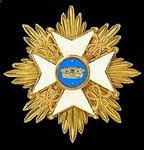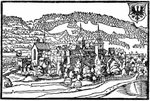First raised 1635 by the Duke of Saxe-Weimar then became a regular French regiment 21st January 1638. Ranked 2nd in the cavalry. Became Mestre de Camp Général 3rd December 1665.
2 squadrons strong.
Stations and actions:
1733: In Italy at Gera d'Adda and at Pizzighetone
1734: Tortona, Parma and Guastalla
1735: Reggiolo and Revere; at the peace stationed at Belfort
1741: Army of Bohemia; refitted at Pontarlier
1743: Battle of Dettingen
1744: At Weissembourg, Augenheim then at the siege of Fribourg
1745: Tournai
1746: Brussels; battle of Rocoux
1747: Battle of Lauffeld
1748: Siege of Maastricht (where the commandant M. de Clermont-Tonnerre was mortally wounded in the assault), then sent to Moulins
1750: Schelestadt
1751: Lons-le-Saulnier
1753: Haguenau
1754: Camp de Plobsheim
1756: Verdun
1757: Sedan; Army of the Lower Rhine [the commandant M. de Bissy was badly wounded and captured at Rossbach]; Hastenbeck July 26th, with the cavalry of the left wing
1758: Captured at Minden in March but soon exchanged. At the battle of Krefeld on the left wing of the first line
1759: With the main army under Contades and at Minden August 1st. Heavy losses at Minden and so sent to the rear afterwards.
1760: Guarding the coast
1761: Increased to 4 squadrons
1763: 4th April Incorporated the regiment of Seyssel
And this was the uniform in 1761:






















